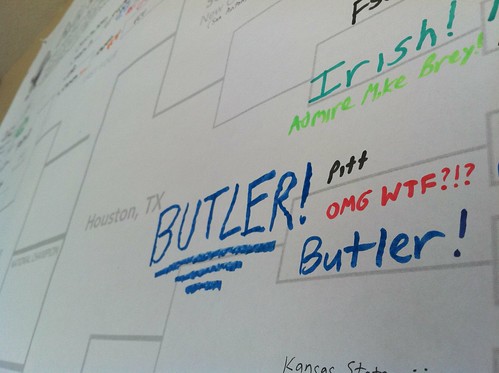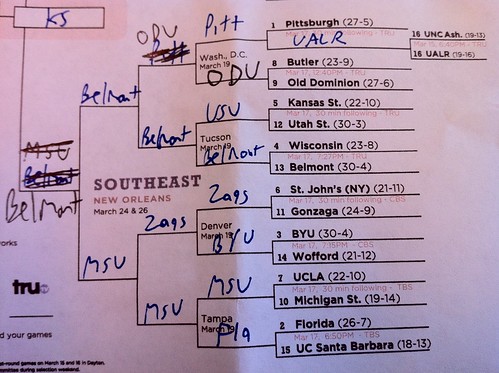When I set up the first Living Room Times NCAA Pool in 1996, I was using a primitive piece of DOS software (yes, DOS!) that assigned, by default, point values through the tournament’s six rounds in a 5-7-10-15-20-25 fashion. I’m not sure if this was customizable, but even if it was, I gave it zero thought. I’d never run an NCAA Pool before, after all, so I had no basis on which to doubt the wisdom of the proposed point totals. I just went with the software’s built-in scoring system.
Over the years, however, it became clear that this scoring system was wildly imperfect. Picking the national champion shouldn’t be worth only 5 times more than picking each first-round winner. With 32 first-round games, such a system makes the first round (as a whole) worth more than the Elite Eight, Final Four and national title game combined! Put another way, the first round is worth almost six-and-a-half-times more than the “sixth round” (the title game). Put yet another way, more than 55% of the total points available in the entire pool are given out on the tournament’s first weekend! Basically, the system doesn’t sufficiently reward picking the right teams at the end.
But while I recognized this, I never wanted to change the scoring system, because I liked the ability to historically compare scores over the pools’ 15-year life span. It emphasized how long I’ve been doing the pools, and added drama to late rounds in pools where the champion is already known (e.g., “will Mike Tran break the all-time points record”?).
The NCAA’s addition of the “First Four,” however, has forced my hand. While it was possible to ignore the #PIG (play-in game) because the winner was a #16 seed which was just going to lose its next game anyway, the #quadPIG cannot be ignored because two of the winners will be at-large teams, #11 or #12 seeds with serious hopes of reaching the second weekend and beyond. The play-in games now have to be included in the pool. This not only shortens the pool signup window, it also means that it’s no longer possible to maintain the historical 5-7-10-15-20-25, maximum-477-points-total scoring model that I’ve been using since Bill Clinton’s first term as president.
Even a small tweak, like, say, making the First Four games worth 3 apiece, then leaving everything else the same (or, say, reducing the 15 to 13 and making each First Four game worth 2, thus maintaining the 477-point max with a 2-5-7-10-13-20-25 system), would throw off and ultimately invalidate the historical comparisons, which were the only reason I’ve kept using the stupid 5-7-10-15-20-25 system all these years. So I’ve decided to completely throw it out and start from scratch.
But what to replace it with?
Many pools use a 1-2-4-8-16-32 system, making each round worth the same amount (32 points), but the individual games worth twice as much with each successive round. Although it has a great internal symmetry and logic, I’ve never liked that system, because I think it makes the later rounds too important, and thus the first and second rounds too unimportant. In other words, it’s the opposite extreme from the 5-7-10-15-20-25 system. I want a happy medium.
At the same time, I’m fond of scoring systems that allow for “upset points,” in which you get extra credit for picking the lower seed to win, thus discouraging overly “chalky” brackets. But upset points shouldn’t completely overwhelm the scoring — for instance, you shouldn’t get three or four times as many points for predicting a 12-over-5 upset as you do for picking the #5 — lest wild brackets that pick an inordinate number of upset picks — many of them wrong, but a handful right — get an unfair advantage over more reasonable brackets. (Rule of thumb: if picking all four #12s, and going 1-for-4, gets you anywhere near as many points than picking all four #5s, and going 3-for-4, that’s no good.) Also, the relative impact of upset points should fade somewhat in the tournament’s later rounds, lest the person who had George Mason plus a bunch of incorrect Final Four picks get hopelessly far ahead of the person who missed Mason but got LSU, UCLA and Florida right, and picked Florida over UCLA in the final (for instance). The Mason picker deserves major bonus points, but not a virtual win-the-pool-free card.
Keeping these principles in mind, I am considering the following scoring system for this year’s men’s pool:
FIRST FOUR (quad-PIG): 8 points per correct pick
ROUND OF 64: 15 points per correct pick + 1 times the seed of the winning team
ROUND OF 32: 25 points per correct pick + 2 times the seed of the winning team
SWEET SIXTEEN: 40 points per correct pick + 3 times the seed of the winning team
ELITE EIGHT: 70 points per correct pick + 4 times the seed of the winning team
FINAL FOUR: 105 points per correct pick + 5 times the seed of the winning team
TITLE GAME: 160 points per correct pick + 6 times the seed of the winning team
That means the total number of points available (not including upset picks) in each round (as a whole) are: 32 for the First Four, and then for the six full rounds, 480-400-320-280-210-160. That’s a much more gradually declining slope than the 160-112-80-60-40-25 of my old system (in percentage terms, the proposed system is 26%-22%-17%-15%-11%-9%, versus the old 34%-23%-17%-13%-8%-5%). Obviously, it’s not the symmetrical 16.66%-per-round distribution of a 1-2-4-8-16-32 system, but as I said, I don’t like that system’s overemphasis on later rounds. I think my system is a pretty decent happy medium.
To play out a couple of scenarios, if one #12 seed pulls a first-round upset, our hypothetical 3-for-4 picker of all #5s over #12s would get 60 points for his trouble, while the 1-for-4 picker of all #12s over #5s would get 27 points. Meanwhile, someone who went 3-for-4 because they picked two #12s, the one that won and another that lost, would get 67 points (7 more than the “chalky” 3-for-4 contestant). Finally, someone who went 2-for-4 because they picked the “wrong” #12 seed, and thus got one upset pick wrong and one non-upset pick wrong — this is what always seems to happen to me — would get 40 points, while somebody who went 2-for-4, but had the upset as one of their 2 correct picks, would get 47 points. It’s hard to be scientific about this, but that strikes me as roughly the right balance.
As for my aforementioned 2006 Final Four scenario, the person who picked George Mason to reach the Final Four, but got all the other Final Four teams wrong, would get 114 points, while the person who picked #2 UCLA, #3 Florida and #4 LSU, but not #11 Mason, would get 246 points. That’s barely twice as much as the Mason guy, which is actually a nice bonus for Mason guy, considering he got fully 3x fewer Final Four teams right. I think that’s fine, but I don’t want him to get too much of a bonus, considering he still only got one Final Four team right. Meanwhile, somebody who got both Mason and LSU, but not the others, would get 200 points — well ahead of somebody who got just UCLA and Florida (180), but well behind our 3-for-4 UCLA-Florida-LSU guy (246). However, if somebody got Mason, Florida and UCLA, they’d be sitting pretty at 274, well ahead of the chalkier UCLA-Florida-LSU 3-for-4 contestant (246). Basically, correctly picking the upset gives you a strong “tiebreaker”-like advantage over somebody who got roughly the same number of games right in a given round, but it won’t generally vault you ahead of somebody who got a much higher overall percentage of picks right. Again, I think that’s just about how it should be.
Anyway, I’m just wondering if anyone has any thoughts. Ultimately, this is my call as the Living Room Times Pool Dictator :), but I value any feedback that readers and contestants might have.










